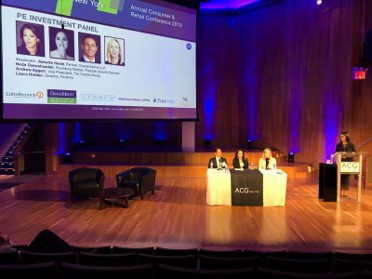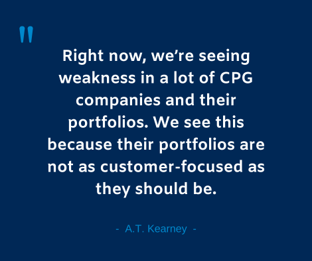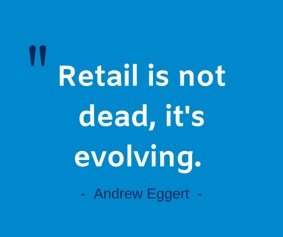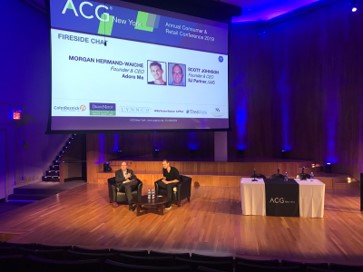![]()
For anyone that works in or around the branded consumer space there is one question at the top of your mind – “what’s next for consumer and retail?” There is no denying that the ecosystem is changing at a rapid pace due to the explosion of ecommerce and direct to consumer – in essence we’ve created a consumer that demands access to products faster, and easier than ever. There’s no going back to a tedious, uneducated buying process from here – retailers, manufacturers, advertisers, and yes, even investors, will have to step up to the challenge.
I recently had the opportunity to attend ACG New York’s Consumer and Retail Conference and hear from a variety of experts in the Consumer space – including Al Sambar from Accenture, Neda Daneshzadeh from Prelude Capital Partners, and José P. Chan from Parson, among others. Al’s key takeaway was simple, fragmentation is here to stay because consumers want options, and they always will. Disrupters, that means it’s your time to shine, and potentially take key market share away from the legacy brands.

What does that mean for brands?
Business Models Are Evolving
It’s time to move to the flywheel business model and embrace “integrated commerce” over “omni channel.” When you think about the consumer buying process, we now have the power to buy almost anything, anywhere, due to the power of smartphones. The issue arising however is that not only do consumers want to be able to purchase products now, they want them in their hands now. Consumers don’t want to buy a new hairdryer and it arrives next week, they want to buy it while at work and have it sitting on their front step when they get home. An interesting point came up at the conference about how consumers are even impacting consumer services due to the “here and now” theory. Think about Peloton, they are a consumer brand allowing individuals to purchase their fitness class, and consume their class, all without leaving their home.
We all understand that the millennial population is largely driving these changes, but the millennial generation is still 4 years away from being the peak spenders, and 10 years away from their peak earnings. As this population, and the generation coming behind it, continue to increase their ability to shift purchasing habits, legacy brands will have to prepare for how it will impact their shelf space.
![]()
As this population continues to increase their spending, we can expect brands to increase their points of purchase, but continue to reduce their retail footprint. What does that mean exactly? Retailers will be forced to innovate, and create experiences that draw consumers to their point of purchase – whether that be to a brick and mortar store, a pop up activation, an app on a smartphone, or their in-home digital assistant.
Supply Chains Are Being Put To The Test
Legacy supply chains are, for obvious reasons, unable to support the ever evolving direct to consumer landscape. This burden is creating new opportunities for the ecosystem supporting these brands – technology companies, contract manufacturers, packaging, and shipping solutions, among others. Many legacy companies are looking to AI as quickly as possible as a means to reduce their human workforce and ultimately decrease lead time and reduce errors. Companies like Macondo Vision are taking the opportunity to maximize the efficiencies of human capital in environments already utilizing advanced engineering technology.
Valuations Are High
In terms of M&A, valuations are still high and there is plenty of dry powder to spend. Legacy brands, as well as private equity groups, need to refresh their current portfolio of brands and are willing to pay a steep price tag to do so. Recent examples include Sheshiedo acquiring Drunk Elephant for $845m (1) and Java Ventures acquiring Coffee Bean and Tea Leaf for $350m (2). According to Pwc the transaction value of Consumer deals in Q3 2019 topped $10.5b (2).

“Right now, we’re seeing weakness in a lot of CPG companies and their portfolios. We see this because their portfolios are not as customer-focused as they should be,” said A.T. Kearney partner Bahige El-Rayes. “Customers are shifting their appetite from big brands to smaller brands, to brands that connect to their values (3).”
The flip side of high valuations is that disruptor brands will have to prove their passions can lead to actual profits, not just hockey stick growth projections. Right now many venture firms are treating beauty much like they do tech – growth at all costs. But, it’s important that as entrepreneurs bring on outside capital in the early years, they create growth plans that are sustainable and realistic because they will have to answer to them as the partnership evolves and investors are looking for returns.
At 7 Mile we believe that the cultural fit of a transaction is just as important, if not more important, than the dollar amount on the table. These disruptor brands are built by real people with real passions, it’s what makes them so successful and it’s imperative that as outside investors and brands begin to acquire or partner with them they don’t lose the “secret sauce.” For legacy brands to see the return on a 1 billion investment (for example, Unilever acquiring Dollar Shave Club) there must be some intrinsic value that can be cross multiplied across the organization.
Evolve Or Die

“Retail is not dead, it’s evolving” – Andrew Eggert, Vice President at The Carlyle Group.
I think we can safely say the “end of retail” is not right around the corner as the news has been warning for the past decade, especially because the adoption of technology allows retail to essentially be everywhere, as I mentioned earlier. Yes, there is a decrease in sales and foot traffic to legacy brick and mortar locations, UBS estimates that by 2026 over 75,000 brick and mortar stores will shut down (4). However, that number does not account for the addition of experiential retail that many retailers, ecommerce and legacy, are beginning to explore. Examples include Neiman Marcus adding a “multi-level retail experience” in Manhattan, New Jersey’s American Dream Mall, and “pop up” stores by brands such as Allbirds and Casper. I even came across an article that compiled a list of “Pop ups in New York City: The most instagrammable shops and experience (6).”
“The retail environment is changing faster than ever, but the value of service, speed, convenience and newness remain constant,” says Brian Gill, technology senior vice president at Nordstrom (5).

As consumers continue demanding more, brands, technology providers, and investors will be forced to step up and take on the evolution head on – either through innovative thinking, technological advances, or purchasing what it would take too long to build.
A few interesting articles:
- He Used to Work at Starbucks. Now This Founder’s Coffee Empire Is Closing In on a Valuation of $1 Billion
- Retail’s Flywheel Business Model
- 5 Trends Driving Retail M&A Deals
Footnotes:
- https://wwd.com/beauty-industry-news/skin-care/shiseido-acquires-drunk-elephant-845-million-1203338755-1203338755/
- https://www.pwc.com/us/en/industries/consumer-markets/library/quarterly-deals-insights.html
- https://www.cnbc.com/2019/04/01/looming-downturn-wont-slow-consumer-retail-ma-at-kearney.html
- https://www.pymnts.com/news/retail/2019/brick-and-mortar-physical-store-closures/
- https://www.themiddlemarket.com/list/5-trends-driving-retail-m-a
- https://www.amny.com/things-to-do/nyc-pop-ups-1.31425257/
About 7 Mile Advisors:
7 Mile Advisors provides Investment Banking & Advisory Services to the Business Services & Technology Industries globally. 7 Mile Advisors advises on M&A and private capital transactions, and provides market assessments and benchmarking. As a close-knit team with a long history together and a laser focus on our target markets, 7 Mile Advisors helps its clients sell companies, raise capital, grow through acquisitions, and evaluate new markets. For more information, including research on the M&A markets, visit www.7mileadvisors.com.
